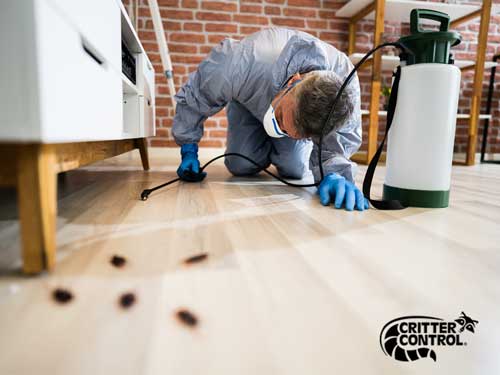Bed Insect Treatment Failure: Contrasting Chemical Vs. Non-Chemical Solutions
In the realm of bug control, especially when handling the persistent issue of bed insects, the selection between chemical and non-chemical therapy remedies can be an essential one. Both approaches provide unique benefits and downsides, influencing aspects such as effectiveness, security factors to consider, and general cost. By taking a look at the nuanced details of each method, a clearer understanding of which course to go after in addressing a bed pest infestation can be obtained.
Performance of Chemical Treatments
Chemical therapies for bed insect infestations have actually been commonly recognized for their fast and powerful effectiveness in eradicating these insects. When considering the efficiency of chemical therapies, it is essential to comprehend that they can supply a fast and thorough remedy to a bed insect problem. Professional pest control experts often rely on pesticides to target bed bugs at numerous phases of their life process, consisting of grownups, nymphs, and eggs. These chemicals commonly function by interfering with the bed bugs' nerves, causing paralysis and ultimate fatality.
Furthermore, chemical therapies have the advantage of offering residual results, indicating that they can remain to get rid of bed bugs even after the initial application. This residual activity is especially helpful in combating any type of potential re-infestations. Furthermore, the quick activity of chemical treatments can bring alleviation to individuals dealing with severe bed pest problems, allowing them to reclaim control of their living rooms quickly.
Safety Worry About Chemical Solutions
One vital element that requires cautious factor to consider when utilizing chemical remedies for bed insect treatment is ensuring the safety and security of residents and the environment. Exposure to certain chemicals made use of in bed insect therapies can lead to breathing issues, skin irritability, or various other unfavorable responses, especially in people with pre-existing conditions or level of sensitivities.
Additionally, the environmental effect of chemical solutions is another significant factor to consider. Some chemicals made use of in bed bug treatments might be unsafe to helpful bugs, wildlife, and ecosystems if they seep into the dirt or water supply. It is important to make use of chemical therapies sensibly, adhering to safety guidelines, and considering less poisonous options to minimize these risks and make sure the efficient and secure administration of bed pest problems.
Benefits of Non-Chemical Methods
Taking into consideration the prospective security concerns and ecological effect associated with chemical remedies for bed pest treatment, exploring non-chemical strategies provides a promising choice with several distinctive advantages. Non-chemical therapies are environmentally friendly, as they do not contribute to air or water pollution, making them a lasting choice for pest control.
In addition, non-chemical options can be effective in targeting bed pests, consisting of hard-to-reach locations where chemical therapies may not pass through. Techniques such as heat therapy, vacuuming, heavy steam cleaning, and cushion encasements provide extensive obliteration without the usage of unsafe chemicals. Additionally, non-chemical strategies can be less turbulent, needing very little preparation and enabling quicker reentry into dealt with areas. Generally, going with non-chemical bed bug treatment approaches not just focuses on safety and environmental management yet additionally makes sure detailed and effective bug control.
Limitations of Non-Chemical Treatments

Additionally, non-chemical treatments often need multiple applications to accomplish effective elimination. This can be time-consuming and might not always guarantee full removal of all bed pests and their eggs, particularly in hard-to-reach or surprise places.
Moreover, the success of non-chemical treatments heavily depends on correct implementation and thoroughness, which can be challenging for people without professional proficiency. Insufficient application of non-chemical methods may cause incomplete obliteration, go to website bring about consistent infestations and the demand for added therapies.
Consequently, while non-chemical therapies have their advantages, it is important to recognize these restrictions and consider them when determining one of the most effective method for handling bed bug problems.
Cost Comparison: Chemical Vs. Non-Chemical Options
Given the constraints associated with non-chemical treatments, a vital aspect to review in the context of bed bug administration is the expense comparison between chemical and non-chemical choices. In comparison, non-chemical treatments like warm treatment or heavy steam can be more costly, with costs ranging from $1,000 to $6,000 for a whole home. While the preliminary cost of chemical therapies may seem lower, multiple therapies may be required to completely eradicate the invasion, possibly boosting the overall cost.
Final Thought

Taking into consideration the prospective Visit Your URL safety problems and ecological effect linked with chemical options for bed bug treatment, checking out non-chemical strategies presents an appealing alternative with several unique advantages.Offered the restrictions linked with non-chemical treatments, an essential aspect to evaluate in the context of bed insect management is the expense comparison between chemical and non-chemical choices. In contrast, non-chemical treatments like heat therapy or vapor can be much more costly, with expenses varying from $1,000 to $6,000 for an entire home. While the first cost of chemical therapies may seem lower, multiple therapies might be called for to fully remove the infestation, potentially enhancing the general cost.In conclusion, when comparing chemical and non-chemical bed bug treatment alternatives, it is essential to consider effectiveness, safety, benefits, limitations, and cost.
Comments on “A1 Charlotte Pest Control Companies - Your Neighborhood Pest Specialists”